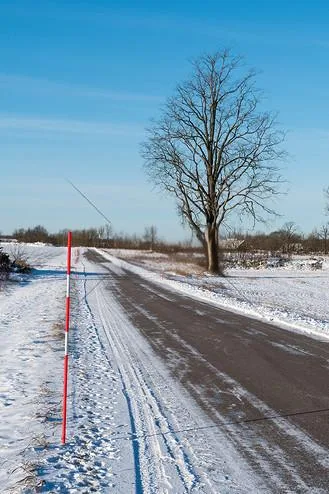Introduction
When winter arrives, clearing snow becomes a top priority for homeowners, especially those with lengthy or curved driveways. One crucial yet often overlooked aspect of effective snow removal is the use of driveway stakes snow plowing. These markers guide drivers, protect landscaping, and ensure that plowing equipment avoids damaging property. In this article, we’ll explore why driveway stakes matter and provide seven pro tips to help you achieve a safe, hassle-free winter.

driveway stakes snow plowing
Why Driveway Stakes Snow Plowing Matters
Reducing Property Damage
Snowstorms and low visibility conditions frequently lead to accidental damage when plowing. According to the Snow & Ice Management Association, property damage from snow-removal equipment can cost homeowners hundreds of dollars in repairs each winter. By installing stakes along the boundaries of your driveway, you create a clear visual guide. This helps you (or your snow removal service) keep the plow blade where it belongs—on the driveway surface, not in your lawn or flowerbeds.
Enhancing Driver Visibility
Visibility during winter storms can be drastically reduced, especially at night or in blizzard conditions. High-contrast driveway stakes not only mark the edges but also serve as beacons for you, delivery drivers, and any visitors. When you invest in quality markers that stand out against a snowy background, you increase the chance everyone stays on the pavement and off any hidden hazards.
7 Pro Tips for Safe Driveway Stakes Snow Plowing
1. Choose the Right Stakes
Quality matters when it comes to driveway stakes snow plowing. Look for stakes made of durable materials such as fiberglass, plastic, or metal, as these tend to withstand heavy snow and ice without bending or breaking. Reflective tops or bands are an added bonus; these catch headlights and make your driveway edges more visible.
2. Measure and Mark Before the Snow Hits
Planning is key. Ideally, you’ll want to position your stakes before the first significant snowfall. Walk the length of your driveway and pinpoint the exact boundaries where the pavement meets grass or landscaping. Using a measuring tape ensures consistent spacing between stakes and helps you avoid guesswork once the snow has already fallen.
3. Ensure Proper Stake Placement
A rule of thumb is to install stakes every 6 to 8 feet along straight sections and slightly closer (about every 4 to 6 feet) along curves or corners. This spacing creates a continuous line of sight, making it much easier for anyone using a snowplow. Drive each stake at least 8 inches into the ground—deep enough to stay firmly in place even as heavy snow and ice accumulate.
4. Opt for High-Visibility Markers
Bright colors—think orange, yellow, or fluorescent green—are a must for driveway stakes. Contrast is everything when you’re plowing at dawn or during a nighttime storm. If your stakes don’t come with reflective tape or tops, consider adding reflective accessories yourself. When headlights hit these markers, they light up, ensuring you can see where to plow without the risk of veering off course.
5. Adjust Your Snow Plow Settings
Modern plows often come with adjustable blades or features that help reduce wear and tear on both the plow and the driveway. If your driveway stakes indicate uneven or raised sections of pavement, make slight adjustments to the blade height. This minimizes scratching or scraping, especially if you have an asphalt or decorative concrete driveway. Keeping the blade slightly off the ground also helps avoid sudden impacts with hidden bumps or ice patches.
6. Maintain Clear Driveway Edges
Snowbanks can quickly pile up along the sides of the driveway, burying stakes and creating a hazard for future snow removals. After each plowing session, inspect the edges. If stakes become dislodged, reposition or replace them right away. Also, keep your eyes out for overhanging tree branches that can drop snow or ice chunks onto your markers.
7. Inspect and Replace Stakes as Needed
Over the course of a snowy season, stakes might bend, crack, or get knocked out of alignment. Routine checks after each major storm ensure your stakes are still doing their job. If they appear damaged or missing, replace them promptly to keep your driveway boundaries clearly marked.
Additional Safety Measures
Proper Snow Removal Gear
For those who handle their own snowplowing, the right gear matters. Invest in weather-resistant gloves, non-slip boots, and multiple layers of clothing. A clear visor or goggles improves visibility during windy, snowy conditions. Proper gear not only keeps you warm but reduces the risk of slips, falls, or mishaps while operating a snowplow.
Utilizing Reflectors and Lighting
In addition to reflective stakes, consider installing extra lighting around your driveway. Motion-sensor lights or additional porch fixtures can illuminate the area, making each pass of the snowplow safer and more precise. If you live in a region prone to heavy snow, solar-powered driveway markers can be an eco-friendly way to boost visibility all season long.
Conclusion
By properly installing and maintaining driveway stakes snow plowing markers, you set yourself up for a safer, damage-free winter. From choosing the right stakes to keeping them visible and in good condition, these strategies help you protect your driveway, lawn, and snow-removal equipment. Ready to take your winter maintenance to the next level? Share your favorite winter safety tip in the comments below, and don’t forget to subscribe to our newsletter for more seasonal home-care tips!




























